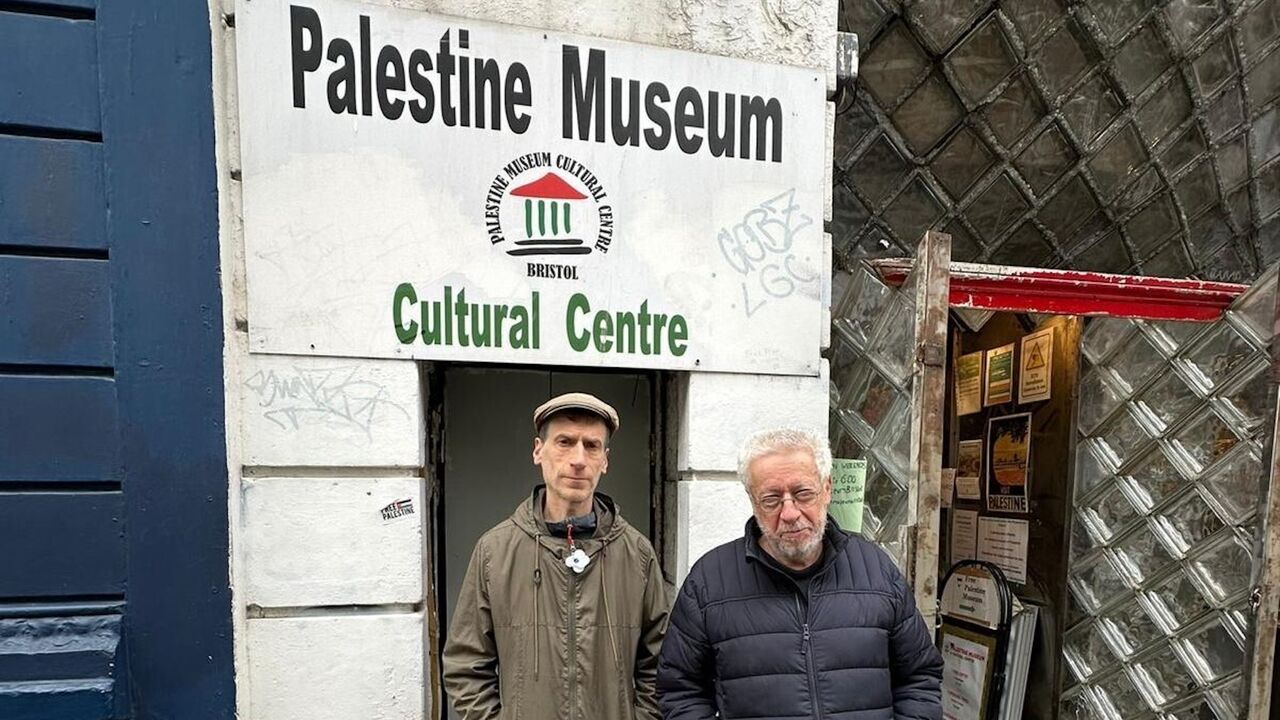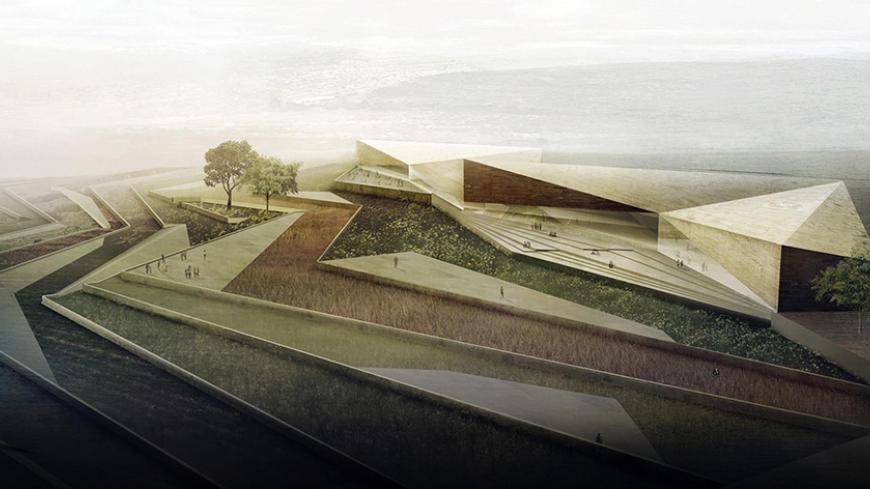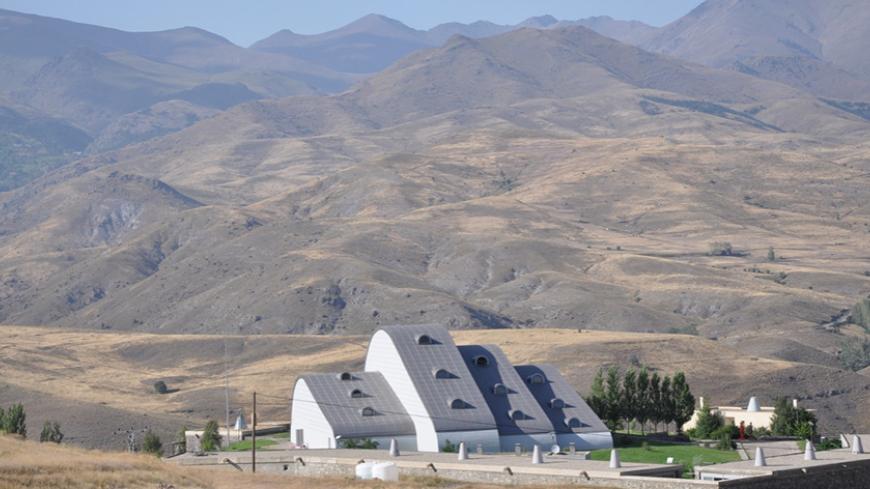Europe's only Palestine museum sees visitors surge in light of Gaza war
Bristol in southwest England is home to Europe’s only Palestine museum, run by unpaid volunteers.

BRISTOL, UK — Many of the most iconic works of world-renowned British street artist Banksy, famous for producing political and provocative murals while maintaining a secret identity, are in the Palestinian territories. They include “Flower Thrower,” “Window on the West Bank” and “Art Attack” as well as the “Walled Off Hotel” — an actual hotel and knockoff of the high-end London Waldorf Hotel — which sits in Bethlehem, mere meters from the towering separation wall between the West Bank and Israeli territory.
Banksy’s home city of Bristol in southwest England is also the site of Europe’s only Palestine Museum. Housed in a former nightclub, the space is now home to fact sheets and artifacts that tell stories spanning Palestine’s pre-mandate history up to the present day.
Born out of activism
The story of the museum begins in 2013, when local activists Eddie Clarke and Rita Cangialosi created an exhibition called "The Nakba Museum and Palestinian Embassy," which was opened by Mayor of Bristol Faruk Choudhury and Palestinian Ambassador to the United Kingdom Manuel Sarkis Hassassian.
The exhibition was created after UNESCO recognized Palestine as a state in 2014 in response to the 2014 Gaza war. The Bristol Coalition for Palestine emerged following mass protests in the city in support of Palestinians. The group met regularly on Sunday afternoons, and from those meetings the idea of the Palestine Museum and Cultural Centre was born.
The Bristol-based museum is run entirely by 50 unpaid volunteers, many of whom are activists in their own right — not just in Middle Eastern politics, but also climate justice and domestic issues like the funding of the UK’s National Health Service. The PMCC is also a registered charity.
The PMCC also runs events (23 last year) and workshops, working with individuals and organizations to educate the public on the Palestinian territories. The museum also supports the Palestinian economy by selling Palestinian-made or sourced products such as olive oil, dates and almonds, as well as keffiyehs, Tatreez embroidery, ceramics and jewelry.
On the surface, Bristol might seem like a strange choice as a venue for a Palestine museum. The city does not have a big Palestinian population compared to London. Asked by Al-Monitor why the museum was established in Bristol, a museum volunteer named Peace said, “Bristol has been the center of activism for the whole of the southwest for hundreds of years, going back a really long time."
He went on, “So it was just activists really at the right place at the right time who had access to this building, and that was key.”
Given that 90% of the museum’s funding comes from individual donations, Peace added that setting it up in London would have been prohibitively expensive.
Post-Oct. 7 spike
The museum has seen its visitor numbers rise sharply since Hamas attacked Israel on Oct. 7 , killing nearly 1,200 people and abducting 240 more, and the ensuing war in Gaza, in which over 35,000 Palestinians have been killed. Visitors nearly doubled from 2022 to 2023, from more than 3,800 people to more than 6,100.
Ron Mendel, a Jewish New York native who volunteers at the PMCC, told Al-Monitor that the increasing number of visitors is one of the “unintended consequences” of the events since Oct 7. “It’s unfortunate that it's taken the suffering of the Palestinian people to encourage people to check out the museum but there's much more interest,” Mendel said.
A former international relations and politics lecturer and long-time activist, Mendel said he is always touched when Palestinians come to the museum and express their appreciation that the museum is “telling our story.”
He said the aim of the museum is to share the day-to-day narrative of the people living in Israeli-occupied territories that have “a history in a very rich heritage and culture, and that needs to be appreciated.”
“That was our messaging before Oct. 7 … that’s been the heart and soul of the museum since its founding,” Mendel added.
Mendel started volunteering at the museum in 2018 after he visited and was impressed to see a whole museum dedicated to Palestine history, culture and heritage. He said he gets “a buzz” from working at the museum and speaking to people about the issue.
“Sometimes you get into conversations with people from all over the world — from Norway to Holland, Germany, France or the UK — and I'm always struck by how people grasp some of the fundamental issues that the heart of the Palestinian experience,” he said.
Palestine focus
Palestinians often visit and speak at the museum. Some join the yearly Palestine Film Festival the museum hosts each December, while others have read poetry. During the week of the anniversary of the Nakba on May 17, that date in 1948 when 750,000 Palestinians were forcibly displaced by the creation of the new state of Israel, the museum hosted several events including poetry, writing and activism workshops. On May 16, a representative of the Women in Hebron cooperative led a Tatreez embroidery workshop.
The museum does not cover Israeli history — it's all from the Palestinian lens. Al-Monitor asked if it was difficult to talk about the plight of the Palestinians without talking about the establishment of Israel and Israeli domestic politics.
“That's exactly right, and we do not address that,” Mendel said. “We don't address the settler population — where they're coming from, what inspires them, how they're organized, who funds them. Those are all pertinent questions, but they do not figure in the Palestine Museum. It's a Palestine museum, it's not an Israeli museum.”
Instead, the museum looks at what the settlements mean to the average Palestinian. “What they mean is draining of their water resources, possibly endangering their olive groves, killing their sheep, taking their land. Having their houses demolished. That's what it means for the Palestinians.”
Mendel said the museum does not deal with the history of what led up to the 1948 establishment of Israel because it would be easy to portray a one-sided perspective and open the museum to criticism. Although the museum talks about Hamas and has a brief display on the origins and evolution of the group, as well as a Hamas flag downstairs on the way up to the Museum display floor, there is very little information on other political parties like Fatah and the Palestinian Authority. Mendel stressed that the exhibition aims to talk about the experience of Palestinians who are not affiliated with any political organization.
Beyond the politics
He emphasized that having political party information and exhibits in the museum help tell the Palestinian story, but are not meant to make a political statement or endorsement. The museum is designed to inform political decisions on the issue based on the facts about living in the Palestinian territories, not portray a political stance.
When museum visitors try to ask Mendel probing questions about the politics of the Israel-Palestine conflict, he offers his own opinion, prefacing it by saying it’s his personal view and not the museum’s.
Because it is funded by individual donations, museum and event entrance fees and selling Palestinian-made products in the gift shop, the PMMC is not under any political pressure to present issues in a certain way, Mendel said.
Still, he hopes the museum sparks more discussion and activism around Palestine.
“The museum tends to reinforce activism and gives people a sense that activism is anchored in something very real. It's just not here and now, but there's a whole history behind it.”







